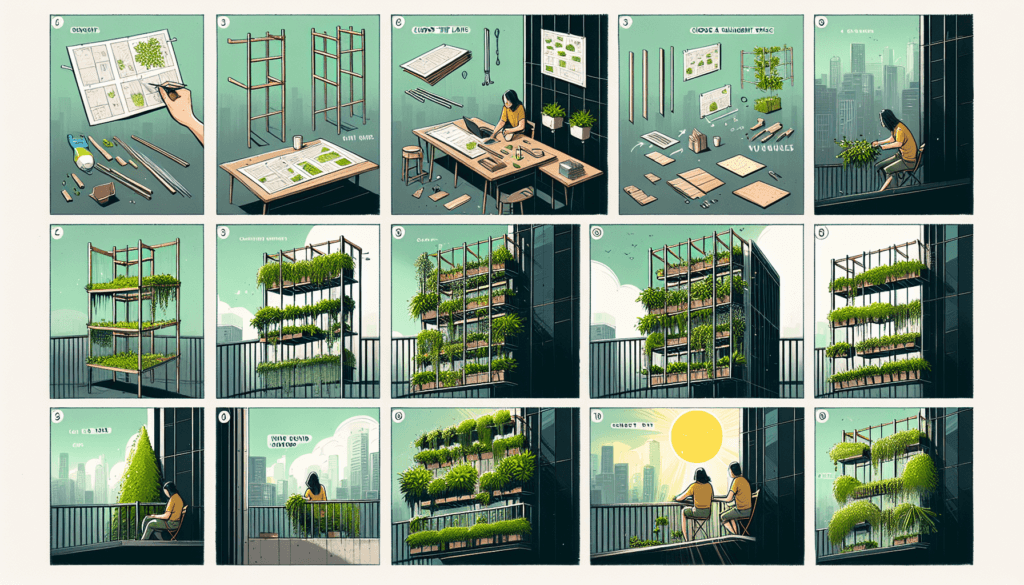Are you a city dweller who longs for a garden oasis but lacks the space? Look no further! In this article, we will explore the wonderful world of DIY vertical planters specifically designed for urban gardens. Whether you have a tiny balcony or a narrow alleyway, these vertical planters are the perfect solution to bring the joy of gardening to your urban abode. With their creative designs and practicality, you’ll soon be enjoying lush greenery and vibrant blossoms, all within the confines of your urban jungle. Get ready to transform your space into a thriving garden paradise with these clever DIY vertical planters.

Choosing the Right Vertical Planter
Consider the Space Available
When choosing a vertical planter for your urban garden, it is crucial to consider the space available. Measure the area where you plan to install the planter and ensure that it can accommodate the size and dimensions of the planter you have in mind. It’s important to choose a planter that fits well in your space so that it doesn’t overpower or overcrowd the area.
Evaluate the Weight Bearing Capacity
Another important factor to consider when choosing a vertical planter is its weight bearing capacity. Depending on the material and construction of the planter, it may have limitations on how much weight it can support. Take into account the weight of the planter itself, the potting soil, and the plants you intend to grow. Ensuring that the planter can bear the weight will prevent any accidents or damage to your garden.
Select the Appropriate Material
Vertical planters come in a variety of materials, each with its own benefits and considerations. Common materials include wood, metal, plastic, and fabric. Wood is a popular choice for its natural aesthetic, while metal provides durability. Plastic and fabric planters are lightweight and easy to move around. Consider factors such as the climate, maintenance requirements, and aesthetic appeal when selecting the material for your vertical planter.
Preparing the Vertical Planter
Clean the Planter
Before planting, it is important to clean the vertical planter to ensure the health and well-being of your plants. Remove any dust, debris, or leftover soil from previous plantings. Use a mild detergent and water to scrub the planter gently. This will help prevent the spread of diseases or pests that may harm your new plants.
Drill Drainage Holes
Drainage is crucial for the health of your plants. Without proper drainage, excess water can accumulate in the planter, leading to root rot and other issues. Use a drill to create drainage holes in the bottom of the planter. This will allow water to flow out freely and prevent waterlogging. Be sure to place a tray or saucer beneath the planter to catch any excess water.
Paint or Seal the Planter
To protect the planter from the elements and add a personal touch to your urban garden, consider painting or sealing it. Choose a paint or sealant that is waterproof and suitable for outdoor use. This will help prevent degradation and extend the lifespan of the planter. Opt for colors that complement your garden’s aesthetic or go for vibrant hues to add a pop of color to your outdoor space.
Choosing the Right Plants
Consider Sunlight Requirements
When choosing plants for your vertical planter, it is important to consider their sunlight requirements. Observe the amount of sunlight exposure your garden receives throughout the day. Some plants thrive in full sun, while others prefer partial or shade. Select plants that match the sunlight conditions in your garden to ensure their healthy growth and development.
Evaluate Watering Needs
Different plants have different watering needs. Some plants require frequent watering, while others prefer drier conditions. Consider the climate and the availability of water in your area when selecting plants for your vertical planter. It’s a good idea to group plants with similar watering requirements together to make it easier to maintain and ensure their watering needs are met.
Select Plants with Compact Growth Habit
To maximize the space in your vertical planter, choose plants with a compact growth habit. Look for plants that stay relatively small or have a trailing or cascading growth pattern. This will allow you to grow multiple plants in a smaller space without overcrowding or compromising the health of the plants. Herbs, succulents, and trailing vines are great options for vertical gardening.
Planting the Vertical Planter
Use Quality Potting Mix
Choosing the right potting mix is essential for the success of your vertical planter. Opt for a high-quality potting mix that is well-draining and nutrient-rich. Avoid using garden soil, as it may contain pests or diseases that can harm your plants. The potting mix should be loose and airy to promote healthy root growth and proper water drainage.
Arrange Plants Strategically
When planting your vertical planter, consider the arrangement of the plants strategically. Place taller plants towards the back and shorter plants towards the front to create depth and visual interest. Experiment with different combinations and placements to find the best layout for your vertical garden. Consider plant spacing to allow room for growth and prevent overcrowding.
Anchor Plants for Stability
To ensure the stability of your vertical planter, it is important to anchor some of the plants. Choose a few plants with strong root systems or trailing vines that can cascade down and help secure the planter. This will prevent the planter from toppling over or swaying in the wind. Plant these anchor plants towards the bottom or sides of the planter for maximum stability.

Watering and Maintenance
Establish a Watering Schedule
Maintaining proper watering is crucial for the health of your plants. Establish a watering schedule based on the needs of the plants you have selected. Factors such as the climate, plant species, and the size of your vertical planter will influence the frequency and amount of watering required. Monitor the soil moisture levels and adjust the watering schedule as necessary.
Monitor Soil Moisture Levels
Regularly check the soil moisture levels in your vertical planter to ensure that it is neither too dry nor overly saturated. Stick your finger about an inch into the soil and check if it feels moist or dry. If the soil feels dry, it’s time to water the plants. However, if it feels consistently wet, you may be overwatering, which can lead to root rot. Proper moisture management is critical for the overall health of your plants.
Prune and Trim Regularly
To maintain the shape and aesthetics of your vertical planter, it is important to prune and trim the plants regularly. Remove any dead or yellowing leaves, as well as any overgrown or tangled branches. This will promote healthy growth and prevent the spread of diseases or pests. Pruning also allows for better air circulation and light penetration, which is beneficial to the plants.
Fertilizing the Vertical Planter
Choose the Right Fertilizer
Proper fertilization is essential to keep your plants healthy and thriving. Choose a fertilizer that is suited to the specific needs of the plants in your vertical planter. Consider factors such as the plant species, growth stage, and nutrient requirements. Select a balanced fertilizer that provides essential nutrients such as nitrogen, phosphorus, and potassium. Organic options are also available for those who prefer a more natural approach.
Follow Application Instructions
When applying fertilizer to your vertical planter, it is important to follow the manufacturer’s instructions. Different fertilizers have varying application rates and frequency. Over-fertilization can lead to nutrient burn and harm your plants, while under-fertilization can result in nutrient deficiencies. Apply the fertilizer evenly and avoid direct contact with the plant foliage.
Apply Fertilizer at Proper Intervals
Timing is critical when it comes to fertilizing your vertical planter. Follow a regular fertilization schedule based on the needs of your plants. Some plants may require more frequent feeding, while others may need less. Avoid fertilizing during extreme weather conditions or when the plants are stressed. Applying fertilizer at the proper intervals will ensure that your plants are receiving the necessary nutrients for healthy growth.

Dealing with Pests and Diseases
Identify Common Garden Pests
Pests and diseases can pose a threat to the health of your vertical planter. Familiarize yourself with common garden pests such as aphids, snails, and spider mites, as well as plant diseases like powdery mildew and root rot. Regularly inspect your plants for any signs of damage or infestation. Early detection is crucial for effective pest management.
Implement Integrated Pest Management
Integrated Pest Management (IPM) is a holistic approach to managing pests that minimizes the use of chemicals. It involves a combination of preventive measures, cultural practices, and biological control. Encourage beneficial insects and birds in your garden to naturally control pests. Use physical barriers such as netting or row covers to protect your plants. If necessary, opt for organic pest control methods to minimize the environmental impact.
Use Organic Pest Control Methods
When dealing with pests in your vertical planter, consider using organic pest control methods. These methods are safe and environmentally friendly alternatives to conventional pesticides. Examples include companion planting, where beneficial plants are interplanted with your desired plants to repel pests. You can also make homemade pest control sprays using ingredients like neem oil or soap and water. Research different organic pest control methods and choose the ones that work best for your garden.
Harvesting from Vertical Planters
Know the Harvesting Time
One of the joys of having a vertical planter is being able to harvest your own fresh produce. It is important to know the harvesting time for each plant in your garden. Different plants have different maturation timelines. Harvesting too early or too late can affect the taste and quality of the produce. Research the optimal harvesting time for your chosen plants and enjoy the fruits of your labor at their peak flavor.
Gently Harvest the Produce
When it’s time to harvest, handle the produce with care. Use scissors or pruners to avoid damaging the plants. Gently remove the fruits, vegetables, or herbs from the plant, taking care not to bruise or crush them. Place the harvested produce in a basket or container to prevent any accidental drops or damage. Enjoy the freshness and flavor of your homegrown harvest.
Maintain Plant Health for Continuous Harvest
To ensure a continuous harvest from your vertical planter, it is important to maintain the health of your plants. Regularly monitor the plants for any signs of disease or nutrient deficiencies. Address any issues promptly to prevent them from spreading or affecting the entire garden. Proper watering, fertilizing, and pruning are key to keeping your plants healthy and productive.

Adding Vertical Planters to Limited Spaces
Utilize Wall Space
If you have limited space in your urban garden, utilize the vertical wall space to add planters. Install vertical planter systems that can be attached to walls or fences. These systems typically have multiple tiers or compartments, allowing you to grow a variety of plants in a small footprint. It’s a great way to maximize your space and create a beautiful green wall.
Hang Planters from Balconies
For those with balconies, hanging planters are an excellent option to add vertical gardening to your space. Hang planters from the balcony railing or the ceiling, creating a stunning display of cascading plants. Choose lightweight and weather-resistant planters that won’t strain the balcony structure. Make sure the hanging planters receive adequate sunlight and water to thrive.
Create a Suspended Planter Installation
Another creative way to incorporate vertical planters into limited spaces is by creating a suspended planter installation. Hang multiple planters at different heights from a structure or ceiling. This creates a visually appealing display and saves floor space. You can group plants with similar care requirements together or mix and match different plant varieties for a vibrant and dynamic installation.
Conclusion
Vertical planters are a wonderful addition to urban gardens, allowing you to maximize limited space and bring greenery to any area. By considering factors such as space availability, weight bearing capacity, and material selection, you can choose the right vertical planter for your needs. Preparing the planter by cleaning, drilling drainage holes, and painting or sealing it ensures a good start for your plants.
When selecting plants, consider their sunlight requirements, watering needs, and growth habits. Planting the vertical planter strategically with quality potting mix and anchoring plants for stability fosters healthy growth. Regular watering, monitoring soil moisture levels, pruning, and fertilizing are essential for maintaining your vertical planter. Implementing integrated pest management and organic pest control methods help keep pests and diseases at bay.
Harvesting from your vertical planter at the right time and gently handling the produce ensures the best flavor and quality. Adding vertical planters to limited spaces can be done by utilizing wall space, hanging planters from balconies, or creating a suspended planter installation.
With the right planning and care, your vertical planter will transform your urban garden into a thriving and beautiful green oasis. Happy vertical gardening!



